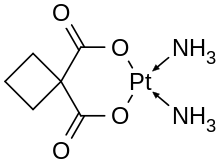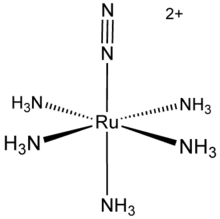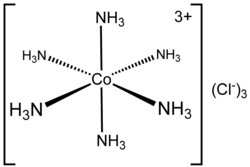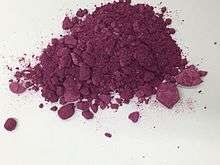Metal ammine complex
In coordination chemistry, metal ammine complexes are metal complexes containing at least one ammonia (NH3) ligand. "Ammine" is spelled this way due to historical reasons; in contrast, alkyl or aryl bearing ligands are spelt with a single "m". Almost all metal ions bind ammonia as a ligand, but the most prevalent examples of ammine complexes are for Cr(III), Co(III), Ni(II), Cu(II) as well as several platinum group metals.[1]
-3D-balls.png)
History

Ammine complexes played a major role in the development of coordination chemistry, specifically determination of the stereochemistry and structure. They are easily prepared, and the metal-nitrogen ratio can be determined by elemental analysis. Through studies mainly on the ammine complexes, Alfred Werner developed his Nobel Prize-winning concept of the structure of coordination compounds (see Figure).[3][4]
One of the first ammine complexes to be described was Magnus' green salt, which consists of the platinum tetrammine complex [Pt(NH3)4]2+.[5]
Examples
Homoleptic poly(ammine) complexes are known for many of the transition metals. Most often, they have the formula [M(NH3)6]n+ where n = 2, 3, and even 4 (M = Pt).[6]
Platinum group metals
Platinum group metals form diverse ammine complexes. Pentaamine(dinitrogen)ruthenium(II) and the Creutz–Taube complex are well studied examples or historic significance. The complex cis-PtCl2(NH3)2, under the name Cisplatin, is an important anticancer drug. Pentamminerhodium chloride is the dichloride salt of the dicationic pentammine complex [RhCl(NH3)5]2+. This salt is an intermediate in the purification of rhodium from its ores.
- Metal-Ammine Complexes
 Carboplatin, a widely used anticancer drug.
Carboplatin, a widely used anticancer drug.Cl2.png) Pentamminerhodium chloride, the dichloride salt one a cationic pentammine halide complex.
Pentamminerhodium chloride, the dichloride salt one a cationic pentammine halide complex. Pentaamine(dinitrogen)ruthenium(II)], the first metal dinitrogen complex.
Pentaamine(dinitrogen)ruthenium(II)], the first metal dinitrogen complex. Hexamminecobalt(III) chloride, the trichloride salt of the hexammine complex [Co(NH3)6]3+. It is famously stable in concentrated hydrochloric acid.
Hexamminecobalt(III) chloride, the trichloride salt of the hexammine complex [Co(NH3)6]3+. It is famously stable in concentrated hydrochloric acid. Reinecke's salt features a very stable anionic diamine complex of Cr(III), which is used as a counteranion.
Reinecke's salt features a very stable anionic diamine complex of Cr(III), which is used as a counteranion.
Cobalt(III) and chromium(III)
The ammines of chromium(III) and cobalt(III) are of historic significance. Both families of ammines are relatively inert kinetically, which allows the separation of isomers.[7] For example, tetraamminedichlorochromium(III) chloride, [Cr(NH3)4Cl2]Cl, has two forms - the cis isomer is violet, while the trans isomer is green. The trichloride of the hexaammine (hexamminecobalt(III) chloride, [Co(NH3)6]Cl3) exists as only a single isomer. "Reinecke's salt" with the formula NH4[Cr(NCS)4(NH3)2].H2O was first reported in 1863.[8]
Nickel(II), zinc(II), copper(II)

Zinc(II) forms a colorless tetraammine with the formula [Zn(NH3)4]2+.[9] Like most zinc complexes, it has a tetrahedral structure. Hexaamminenickel is violet, and the copper(II) complex is deep blue. The latter is characteristic of the presence of copper(II) in qualitative inorganic analysis.
Copper(I), silver(I), and gold(I)
Copper(I) forms only labile complexes with ammonia, including the trigonal planar [Cu(NH3)3]+.[10] Silver gives the diammine complex [Ag(NH3)2]+ with linear coordination geometry.[11] It is this complex that forms when otherwise rather insoluble silver chloride dissolves in aqueous ammonia. The same complex is the active ingredient in Tollen's reagent. Gold(I) chloride forms a compound with six ammonia, but X-ray crystallography reveals that only two ammonia molecules are ligands.[12]
Reactions
Ligand exchange and redox reactions
Since ammonia is a stronger ligand in the spectrochemical series than water, metal ammine complexes are stabilized relative to the corresponding aquo complexes. For similar reasons, metal ammine complexes are less strongly oxidizing than are the corresponding aquo complexes. The latter property is illustrated by the stability of [Co(NH3)6]3+ in aqueous solution and the nonexistence of [Co(H2O)6]3+ (which would oxidize water).
Acid-base reactions
Once complexed to a metal ion, ammonia is not basic. This property is illustrated by the stability of some metal ammine complexes in strong acid solutions. When the M-NH3 bond is weak, the ammine ligand dissociates and protonation ensues. The behavior is illustrated by the non-reaction and reaction with [Co(NH3)6]3+ and [Ni(NH3)6]2+, respectively.
The ammine ligands are more acidic than is ammonia (pKa ~ 33). For highly cationic complexes such as [Pt(NH3)6]4+, the conjugate base can be obtained. The deprotonation of cobalt(III) ammine-halide complexes, e.g. [CoCl(NH3)5]2+ labilises the Co-Cl bond, according to the Sn1CB mechanism.
Applications
Metal ammine complexes find many uses. Cisplatin (PtCl2(NH3)2) is a coordination compound containing two chloro and two ammine ligands. This is a drug used in treating cancer.[13] Many other amine complexes of the platinum group metals have been evaluated for this application.
In the separation of the individual platinum metals from their ore, several schemes rely on the precipitation of [RhCl(NH3)5]Cl2. In some separation schemes, palladium is purified by manipulating equilibria involving [Pd(NH3)4]Cl2, PdCl2(NH3)2, and Pt(NH3)4[PdCl4].
In the processing of cellulose, the copper ammine complex known as Schweizer's reagent ([Cu(NH3)4(H2O)2](OH)2) is sometimes used to solubilise the polymer. Schweizer's reagent is prepared by treating an aqueous solutions of copper(II) ions with ammonia. Initially, the light blue hydroxide precipitates only to redissolve upon addition of more ammonia:
- [Cu(H2O)6]2+ + 2 OH− → Cu(OH)2 + 6 H2O
- Cu(OH)2 + 4 NH3 + 2 H2O → [Cu(NH3)4(H2O)2]2+ + 2 OH−
Silver diammine fluoride ([Ag(NH3)2]F) is a topical medicament (drug) used to treat and prevent dental caries (cavities) and relieve dentinal hypersensitivity.[14]
See also
References
- A. von Zelewsky "Stereochemistry of Coordination Compounds" John Wiley: Chichester, 1995. ISBN 0-471-95599-X.
- Alfred Werner "Beitrag zur Konstitution anorganischer Verbindungen" Zeitschrift für anorganische Chemie 1893, Volume 3, pages 267–330.doi:10.1002/zaac.18930030136
- "Werner Centennial" George B. Kauffman, Ed. Adv. Chem. Ser., 1967, Volume 62. ISBN 978-0-8412-0063-0
- von Zelewsky, A. "Stereochemistry of Coordination Compounds" John Wiley: Chichester, 1995. ISBN 0-471-95599-X.
- Atoji, M.; Richardson, J. W.; Rundle, R. E. (1957). "On the Crystal Structures of the Magnus Salts, Pt(NH3)4PtCl4". J. Am. Chem. Soc. 79 (12): 3017–3020. doi:10.1021/ja01569a009.
- Eßmann, Ralf; Kreiner, Guido; Niemann, Anke; Rechenbach, Dirk; Schmieding, Axel; Sichla, Thomas; Zachwieja, Uwe; Jacobs, Herbert (1996). "Isotype Strukturen einiger Hexaamminmetall(II)‐halogenide von 3d‐Metallen: [V(NH3)6]I2, [Cr(NH3)6]I2, [Mn(NH3)6]Cl2, [Fe(NH3)6]Cl2, [Fe(NH3)6]Br2, [Co(NH3)6]Br2, und [Ni(NH3)6]Cl2". Zeitschrift für anorganische und allgemeine Chemie. 622: 1161-1166. doi:10.1002/zaac.19966220709.
- Basolo, F.; Pearson, R. G. "Mechanisms of Inorganic Reactions." John Wiley and Son: New York: 1967. ISBN 0-471-05545-X
- Reinecke, A. "Über Rhodanchromammonium-Verbindungen" Annalen der Chemie und Pharmacie, volume 126, pages 113-118 (1863). doi: 10.1002/jlac.18631260116.
- Essmann, R. (1995). "Influence of coordination on N-H...X- hydrogen bonds. Part 1. [Zn(NH3)4]Br2 and [Zn(NH3)4]I2". Journal of Molecular Structure. 356: 201–6. Bibcode:1995JMoSt.356..201E. doi:10.1016/0022-2860(95)08957-W.
- Nilsson, Kersti B.; Persson, Ingmar (2004). "The coordination chemistry of copper(I) in liquid ammonia, trialkyl and triphenyl phosphite, and tri-n-butylphosphine solution". Dalton Transactions (9): 1312–1319. doi:10.1039/B400888J.
- Nilsson, K. B.; Persson, I.; Kessler, V. G. (2006). "Coordination Chemistry of the Solvated AgI and AuI Ions in Liquid and Aqueous Ammonia, Trialkyl and Triphenyl Phosphite, and Tri-n-butylphosphine Solutions". Inorganic Chemistry. 45: 6912. doi:10.1021/ic060175v.
- Scherf, L. M.; Baer, S. A.; Kraus, F.; Bawaked, S. M.; Schmidbaur, H. (2013). "Implications of the Crystal Structure of the Ammonia Solvate [Au(NH3)2]Cl·4NH3". Inorganic Chemistry. 52: 2157-2161. doi:10.1021/ic302550q.
- S. J. Lippard, J. M. Berg "Principles of Bioinorganic Chemistry" University Science Books: Mill Valley, CA; 1994. ISBN 0-935702-73-3.
- Rosenblatt, A.; Stamford, T. C. M.; Niederman, R. (2009). "Silver diamine fluoride: a caries "silver-fluoride bullet"". Journal of Dental Research. 88: 116–125. doi:10.1177/0022034508329406. PMID 19278981.CS1 maint: uses authors parameter (link)